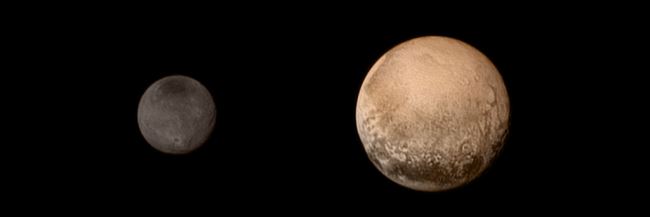Why is Mercury a Planet and Not Pluto
 NASA/Johns Hopkins University Applied Physics Laboratory/Southwest Research Institute (JHUAPL/SwRI) => http://pluto.jhuapl.edu/Multimedia/Images/Artist-Renderings.php, Public domain, via Wikimedia Commons
NASA/Johns Hopkins University Applied Physics Laboratory/Southwest Research Institute (JHUAPL/SwRI) => http://pluto.jhuapl.edu/Multimedia/Images/Artist-Renderings.php, Public domain, via Wikimedia Commons
What rules did scientists impose to remove Pluto from the list of Planets in our Solar System? Why is Mercury still on the list? Read on to learn what changes were made and where Pluto went.
On the edge of the solar system orbits a family of small icy worlds. Discovered in 1930, Pluto became known as our ninth planet. Unfortunately for Pluto, the IAU removed Pluto from the list of planets and reclassified it; instead making it a dwarf planet. Why did it get removed? What does Mercury have that Pluto does not?
The Dwarf Planet Pluto
Pluto is a very small, icy world, with a highly inclined and elliptical orbit. At times it orbits closer to the sun than Neptune. It’s overall distance from the sun leaves the planet icy and cold enough to freeze most compounds you think of as gases. Pluto has a small thin atmosphere of nitrogen and carbon monoxide with small amounts of methane.
-
- Named after the Greek god of the underworld
- Pluto has five known moons.
- One Third Water
- Pluto has been visited by one spacecraft.

NASA-JHUAPL-SWRI, Public domain, via Wikimedia Commons
Pluto and Charon (moon)The Planet Mercury
Little was known about the planet Mercury until 1974-1975. That year the Mariner 10 spacecraft flew past Mercury and revealed a planet with heavily cratered surface resembling Earth’s moon. Data showed that large areas had been flooded by lava and then cratered. The planet also has curved cliffs known as lobate scarps. Scientists believe that they formed from compression, and think the entire crust became compressed a long time ago.
-
- Mercury does not have any moons or rings.
- Your weight on Mercury would be 38% of your weight on Earth.
- A day on the surface of Mercury lasts 176 Earth days.
- A year on Mercury takes 88 Earth days.
- Mercury has a diameter of 4,879 km, making it the smallest planet.
What Makes A Planet a “Planet” ?
Similar to the asteroid belt, the Kuiper Belt, located beyond Neptune, consists mainly of small bodies or remnants from when the Solar System formed. The belt appears larger than a normal asteroid belt-20 times as wide and 20 to 200 times as massive.
- Pluto did not grow massive enough to clear its orbital zones of remnant planetesimals. The dwarf planet remains embedded among a swarm of other objects in the Kuiper Belt.
- It must be large enough that its gravity has pulled it into a spherical shape, and also must dominate and gravitationally clear its orbital region of most of all other objects.
- It does not clear the orbital zones of other planets and therefore does not meet the standard for being called a planet.
Not to remain in the background, Pluto led the way to a new class of objects called the dwarf planets. Mercury meets all the criteria for a planet and therefore gets to remain on the list of planets. With newer and better observation crafts, scientists have located 5 dwarf planets. Pluto has company in this new category class. Any body in the Kuiper Belt with enough mass to attain “hydrostatic equilibrium” – meaning that it has enough mass that its gravity crushes it into a sphere – will be another “dwarf planet”.
There may be dozens or hundreds of them, but they are so small and far away that scientists have not found them yet. With any luck they will soon discover more.
SaveSave
